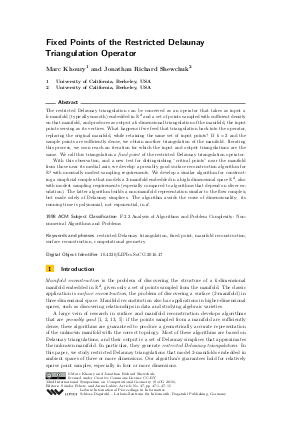Fixed Points of the Restricted Delaunay Triangulation Operator
Authors Marc Khoury, Jonathan Richard Shewchuk
-
Part of:
Volume:
32nd International Symposium on Computational Geometry (SoCG 2016)
Part of: Series: Leibniz International Proceedings in Informatics (LIPIcs)
Part of: Conference: Symposium on Computational Geometry (SoCG) - License:
 Creative Commons Attribution 3.0 Unported license
Creative Commons Attribution 3.0 Unported license
- Publication Date: 2016-06-10
File

PDF
LIPIcs.SoCG.2016.47.pdf
- Filesize: 434 kB
- 15 pages
Document Identifiers
Subject Classification
Keywords
- restricted Delaunay triangulation
- fixed point
- manifold reconstruction
- surface reconstruction
- computational geometry
Metrics
- Access Statistics
-
Total Accesses (updated on a weekly basis)
0PDF Downloads0Metadata Views
Abstract
The restricted Delaunay triangulation can be conceived as an operator that takes as input a k-manifold (typically smooth) embedded in R^d and a set of points sampled with sufficient density on that manifold, and produces as output a k-dimensional triangulation of the manifold, the input points serving as its vertices. What happens if we feed that triangulation back into the operator, replacing the original manifold, while retaining the same set of input points? If k = 2 and the sample points are sufficiently dense, we obtain another triangulation of the manifold. Iterating this process, we soon reach an iteration for which the input and output triangulations are the same. We call this triangulation a fixed point of the restricted Delaunay triangulation operator. With this observation, and a new test for distinguishing "critical points" near the manifold from those near its medial axis, we develop a provably good surface reconstruction algorithm for R^3 with unusually modest sampling requirements. We develop a similar algorithm for constructing a simplicial complex that models a 2-manifold embedded in a high-dimensional space R^d, also with modest sampling requirements (especially compared to algorithms that depend on sliver exudation). The latter algorithm builds a non-manifold representation similar to the flow complex, but made solely of Delaunay simplices. The algorithm avoids the curse of dimensionality: its running time is polynomial, not exponential, in d.
Cite As Get BibTex
Marc Khoury and Jonathan Richard Shewchuk. Fixed Points of the Restricted Delaunay Triangulation Operator. In 32nd International Symposium on Computational Geometry (SoCG 2016). Leibniz International Proceedings in Informatics (LIPIcs), Volume 51, pp. 47:1-47:15, Schloss Dagstuhl – Leibniz-Zentrum für Informatik (2016)
https://doi.org/10.4230/LIPIcs.SoCG.2016.47
BibTex
@InProceedings{khoury_et_al:LIPIcs.SoCG.2016.47,
author = {Khoury, Marc and Shewchuk, Jonathan Richard},
title = {{Fixed Points of the Restricted Delaunay Triangulation Operator}},
booktitle = {32nd International Symposium on Computational Geometry (SoCG 2016)},
pages = {47:1--47:15},
series = {Leibniz International Proceedings in Informatics (LIPIcs)},
ISBN = {978-3-95977-009-5},
ISSN = {1868-8969},
year = {2016},
volume = {51},
editor = {Fekete, S\'{a}ndor and Lubiw, Anna},
publisher = {Schloss Dagstuhl -- Leibniz-Zentrum f{\"u}r Informatik},
address = {Dagstuhl, Germany},
URL = {https://drops.dagstuhl.de/entities/document/10.4230/LIPIcs.SoCG.2016.47},
URN = {urn:nbn:de:0030-drops-59396},
doi = {10.4230/LIPIcs.SoCG.2016.47},
annote = {Keywords: restricted Delaunay triangulation, fixed point, manifold reconstruction, surface reconstruction, computational geometry}
}
Author Details
References
-
Nina Amenta and Marshall Bern. Surface Reconstruction by Voronoi Filtering. Discrete &Computational Geometry, 22(4):481-504, June 1999.

-
Nina Amenta, Sunghee Choi, Tamal Krishna Dey, and Naveen Leekha. A Simple Algorithm for Homeomorphic Surface Reconstruction. International Journal of Computational Geometry and Applications, 12(1-2):125-141, 2002.

-
Nina Amenta, Sunghee Choi, and Günter Rote. Incremental Constructions con BRIO. In Proceedings of the Nineteenth Annual Symposium on Computational Geometry, pages 211-219, San Diego, California, June 2003. Association for Computing Machinery.

-
Marshall Bern and David Eppstein. Mesh Generation and Optimal Triangulation. In Computing in Euclidean Geometry, volume 1 of Lecture Notes Series on Computing, pages 23-90. World Scientific, Singapore, 1992.

-
Jean-Daniel Boissonnat and Arijit Ghosh. Manifold Reconstruction Using Tangential Delaunayomplexes. Discrete &Computational Geometry, 51(1):221-267, January 2014.

-
Jean-Daniel Boissonnat and Steve Oudot. Provably Good Sampling and Meshing of Surfaces. Graphical Models, 67(5):405-451, September 2005.

-
Jean-Daniel Boissonnat and Steve Oudot. Provably Good Sampling and Meshing of Lipschitzurfaces. In Proceedings of the Twenty-Second Annual Symposium on Computational Geometry, pages 337-346, Sedona, Arizona, June 2006.

-
Siu-Wing Cheng, Tamal Krishna Dey, Herbert Edelsbrunner, Michael A. Facello, and Shang-Hua Teng. Sliver Exudation. Journal of the ACM, 47(5):883-904, September 2000.

-
Siu-Wing Cheng, Tamal Krishna Dey, and Edgar A. Ramos. Manifold Reconstruction from Point Samples. In Proceedings of the Sixteenth Annual Symposium on Discrete Algorithms, pages 1018-1027, Vancouver, British Columbia, Canada, January 2005. ACM-SIAM.

-
Siu-Wing Cheng, Tamal Krishna Dey, and Jonathan Richard Shewchuk. Delaunay Mesh Generation. CRC Press, Boca Raton, Florida, December 2012.

-
Kenneth L. Clarkson and Peter W. Shor. Applications of Random Sampling in Computational Geometry, II. Discrete &Computational Geometry, 4(1):387-421, December 1989.

-
Tamal K. Dey, Joachim Giesen, Edgar A. Ramos, and Bardia Sadri. Critical Points of Distance to an ε-Sampling of a Surface and Flow-Complex-Based Surface Reconstruction. International Journal of Computational Geometry and Applications, 18(1-2):29-62, 2008.

-
Tamal Krishna Dey. Curve and Surface Reconstruction: Algorithms with Mathematical Analysis. Cambridge University Press, New York, 2007.

-
Herbert Edelsbrunner. Surface Reconstruction by Wrapping Finite Sets in Space. In Boris Aronov, Saugata Basu, János Pach, and Micha Sharir, editors, Discrete and Computational Geometry: The Goodman-Pollack Festschrift, pages 379-404. Springer-Verlag, Berlin, 2003.

-
Herbert Edelsbrunner and Nimish R. Shah. Triangulating Topological Spaces. International Journal of Computational Geometry and Applications, 7(4):365-378, August 1997.

-
Julia Flötotto. A Coordinate System Associated to a Point Cloud Issued from a Manifold: Definition, Properties and Applications. PhD thesis, Université Nice Sophia Antipolis, 2003.

-
Joachim Giesen and Matthias John. The Flow Complex: A Data Structure for Geometric Modeling. Computational Geometry: Theory and Applications, 39:178-190, 2008.

